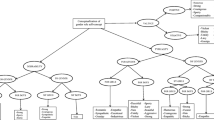Abstract
The present research examined developmental and gender differences in the relative accessibility of different gender stereotype domains. A 1988 Northeastern US sample of 256 children ages 3 to 10 years old provided open-ended descriptions of girls and boys. Responses were coded by domain to examine differences by grade, gender of participant, and gender of target. Analyses revealed that girls and older children provided a higher proportion of stereotypes, and that appearance stereotypes were particularly prevalent in descriptions of girls and activity/trait stereotypes were more prevalent in descriptions of boys. Results are discussed in terms of implications for research on the stereotype knowledge–behavior link and the need for more attention to the role of appearance stereotypes in the gender stereotype literature.
Similar content being viewed by others
References
Albert, A. A., & Porter, J. R. (1986). Children’s gender stereotypes: A comparison of the United States and South Africa. Journal of Cross-Cultural Psychology, 17, 45–65.
American Psychological Association, Task Force on the Sexualization of Girls (2007). Report of the APA Task Force on the sexualization of girls. Washington, DC: American Psychological Association.
Bandura, A., & Bussey, K. (2004). On broadening the cognitive, motivational, and sociocultural scope of theorizing about gender development and functioning: Comment on Martin, Ruble, and Szkrybalo (2002). Psychological Bulletin, 130, 691–701.
Bauer, P. J., Liebl, M., & Stennes, L. (1998). Pretty is to dress as brave is to suit coat: Gender-based property-to-property inferences by 4 1/2-year-old children. Merrill-Palmer Quarterly, 44, 355–377.
Bem, S. L. (1981). Gender schema theory: A cognitive account of sex typing. Psychological Review, 88, 354–364.
Blakemore, J. E. O. (2003). Children’s beliefs about violating gender norms: Boys shouldn’t look like girls and girls shouldn’t act like boys. Sex Roles, 48, 411–419.
Bussey, K., & Bandura, A. (1999). Social cognitive theory of gender development and differentiation. Psychological Review, 106, 676–713.
Campbell, A., Shirley, L., & Caygill, L. (2002). Sex-typed preferences in three domains: Do two-year-olds need cognitive variables? The British Journal of Psychology, 93, 203–217.
Cristofaro, T. N., & Tamis-Lemonda, C. S. (2008). Lessons in mother–child and father–child personal narratives in Latino Families. In A. McCabe, A. L. Bailey, & G. Melzi (Eds.), Spanish-language narration and literacy: Culture, cognition, and emotion (pp. 55–89). New York: Cambridge University Press.
Deaux, K., & Lewis, L. L. (1984). Structure of gender stereotypes: Interrelationships among components and gender label. Journal of Personality and Social Psychology, 46, 991–1004.
Dill, K. E., & Thill, K. P. (2007). Video game characters and the socialization of gender roles: Young people’s perceptions mirror sexist media depictions. Sex Roles, 57, 851–864.
Eckes, T., & Trautner, H. M. (2000). Developmental social psychology of gender: An integrative framework. In T. Eckes, & H. M. Trautner (Eds.), The developmental social psychology of gender (pp. 3–32). Mahwah: Erlbaum.
Edelbrock, C., & Sugawara, A. I. (1978). Acquisition of sex-typed preferences in preschool-aged children. Developmental Psychology, 14, 614–623.
Etaugh, C., & Liss, M. B. (1992). Home, school, and playroom: Training grounds for adult gender roles. Sex Roles, 26, 129–147.
Fazio, R. H. (1990). Multiple processes by which attitudes guide behavior: The mode model as an integrative framework. Advances in Experimental Social Psychology, 23, 75–109.
Fridell, S. R., Zucker, K. J., Bradley, S. J., & Maing, D. M. (1996). Physical attractiveness of girls with gender identity disorder. Archives of Sexual Behavior, 25, 17–31.
Graham, S., Taylor, A. Z., & Hudley, C. (1998). Exploring achievement values among ethnic minority early adolescents. Journal of Educational Psychology, 90, 606–620.
Heyman, G. D., & Legare, C. H. (2004). Children’s beliefs about gender differences in the academic and social domains. Sex Roles, 50, 227–239.
Higgins, E. T. (1996). Knowledge activation: Accessibility, applicability, and salience. In E. T. Higgins & A. W. Kruglanski (Eds.), Social psychology: Handbook of basic principles (pp. 133–168). New York: Guilford.
Higgins, E. T., & Bargh, J. A. (1987). Social cognition and social perception. Annual Review of Psychology, 38, 369–425.
Higgins, E. T., & Brendl, M. (1995). Accessibility and applicability: Some “activation rules” influencing judgment. Journal of Experimental Social Psychology, 31, 218–243.
Higgins, E. T., & King, G. (1981). Accessibility of social constructs: Information processing consequences of individual and contextual variability. In N. Cantor, & J. F. Kihlstrom (Eds.), Personality, cognition and social interaction (pp. 69–121). Hillsdale: Erlbaum.
Higgins, E. T., & Wells, R. S. (1986). Social construct availability and accessibility as a function of social life phase: Emphasizing the “how” versus the “can” of social cognition. Social Cognition, 4, 201–226.
Higgins, E. T., King, G., & Mavin, G. H. (1982). Individual construct accessibility and subjective impressions and recall. Journal of Personality and Social Psychology, 43, 35–47.
Huston, A. C. (1983). Sex-typing. In P. H. Mussen (Ed.), Handbook of child psychology, Vol. 4 (4th ed., pp. 387–467). New York: Wiley.
Kilbourne, J. (2003). Beauty and the beast of advertising. In J. M. Henslin (Ed.), Down to earth sociology: Introductory readings (12th ed.). New York: Free Press.
Liben, L. S., & Bigler, R. S. (2002). The developmental course of gender differentiation. Monographs of the Society for Research in Child Development, 67, 1–147.
Livesly, W. J., & Bromley, D. B. (1973). Person perception in childhood and adolescence. London: Wiley.
Lueptow, L. B., Garovich-Szabo, L., & Lueptow, M. (2001). Social change and the persistence of sex typing: 1974-1997. Social Forces, 80, 1–35.
Martin, C. L., & Halverson, C. (1981). A schematic processing model of sex typing and stereotyping in children. Child Development, 52, 1119–1134.
Martin, C. L., Wood, C. H., & Little, J. K. (1990). The development of gender stereotype components. Child Development, 61, 1891–1904.
Martin, C. L., Ruble, D. N., & Szkrybalo, J. (2002). Cognitive theories of early gender development. Psychological Bulletin, 128, 903–933.
McDermid, S. A., Zucker, K. J., Bradley, S., & Maing, D. M. (1998). Effects of physical appearance of masculine trait ratings of boys and girls with gender identity disorder. Archives of Sexual Behavior, 27, 253–267.
Miller, C. F., Trautner, H. M., & Ruble, D. N. (2006). The role of gender stereotypes in children’s preferences and behavior. In C. Tamis-LeMonda, & L. Balter (Eds.), Child psychology: A handbook of contemporary issues. New York: Psychology Press.
Nolen-Hoeksema, S. (2001). Gender differences in depression. Current Directions in Psychological Science, 10, 173–176.
O’Brien, M. H., Peyton, V., Mistry, R., Hruda, L., Jacobs, A., Caldera, Y., et al. (2000). Gender-role cognition in 3-year-old boys and girls. Sex Roles, 42, 1007–1025.
Ohring, R., Graber, J. A., & Brooks-Gunn, J. (2002). Girls’ recurrent and concurrent body dissatisfaction: Correlates and consequences over 8 years. International Journal of Eating Disorders, 31, 404–415.
Patrick, H., Neighbors, C., & Knee, C. R. (2004). Appearance-related social comparisons: The role of contingent self-perceptions of attractiveness. Personality and Social Psychology Bulletin, 30, 501–514.
Rholes, W. S., Newman, L. S., & Ruble, D. N. (1990). Understanding self and other: Developmental and motivational aspects of perceiving others in terms of invariant dispositions. In E. T. Higgins, & R. Sorrentino (Eds.), Handbook of motivation and cognition: Foundations of social behavior: Vol. 2 (pp. 369–407). New York: Guilford.
Ruble, T. L. (1983). Sex stereotypes: Issues of change in the 1970s. Sex Roles, 9, 397–402.
Ruble, D. N., & Dweck, C. (1995). Self-conceptions, person conceptions, and their development. In N. Eisenberg (Ed.), Review of personality and social psychology: Vol. 15. Social development (pp. 109–135). Thousand Oaks: Sage.
Ruble, D. N., & Martin, C. (1998). Gender development. In N. Eisenberg (Ed.), Handbook of child psychology: Vol. 3, personality and social development (5th ed., pp. 933–1016). New York: Wiley.
Ruble, D. N., Martin, C. L., & Berenbaum, S. (2006). Gender development. In N. Eisenberg (Ed.), Handbook of child psychology: Vol. 3, personality and social development (6th Edn.). New York: Wiley.
Ruble, D. N., Lurye, L. E., & Zosuls, K. M. (2007). Pink frilly dresses (PFD) and early gender identity. Princeton Report on Knowledge, 2. Retrieved January 9, 2009, from http://www.princeton.edu/prok/issues/2-2/pink_frilly.xml
Serbin, L. A., Poulin-Dubois, D., Colburne, K. A., Sen, M. G., & Eichstedt, J. A. (2001). Gender stereotyping in infancy: Visual preferences for and knowledge of gender-stereotyped toys in the second year. International Journal of Behavioral Development, 25, 7–15.
Signorella, M. L., Bigler, R. S., & Liben, L. S. (1993). Developmental differences in children’s gender schemata about others: A meta-analytic review. Developmental Review, 13, 147–183.
Six, B., & Eckes, T. (1991). A closer look at the complex structure of gender stereotypes. Sex Roles, 24, 57–71.
Smetana, J. G. (1986). Preschool children’s conceptions of sex-role transgressions. Child Development, 57, 862–871.
Stoddart, T., & Turiel, E. (1985). Children’s concepts of cross-gender activities. Child Development, 56, 1241–1252.
Thompson, S. K. (1975). Gender labels and early sex-role development. Child Development, 46, 339–347.
Trautner, H. M., Ruble, D. N., Cyphers, L., Kirsten, B., Behrendt, R., & Hartmann, P. (2005). Rigidity and flexibility of gender stereotypes in children: Developmental or differential? Infant and Child Development, 14, 365–380.
Tulving, E., & Pearlstone, Z. (1966). Availability versus accessibility of information in memory for words. Journal of Verbal Learning and Verbal Behavior, 5, 381–391.
Ward, C. (1985). Sex trait stereotypes in Malaysian children. Sex Roles, 12, 35–45.
Williams, J. E., & Best, D. L. (1990). Measuring sex stereotypes: A multination study. Thousand Oaks: Sage.
Williams, J. E., Bennett, S. M., & Best, D. L. (1975). Awareness and expression of sex stereotypes in young children. Developmental Psychology, 11, 635–642.
Zucker, K. J., Wild, J., Bradley, S., & Lowry, C. B. (1993). Physical attractiveness of boys with gender identity disorder. Archives of Sexual Behavior, 22, 23–31.
Acknowledgments
This research was supported in part by the National Institute of Child Health and Human Development Research Grant #HD04994 to Diane N. Ruble. We are very grateful to the children and schools who participated in this study. We thank Judy Kwak and Faith Greulich for their help with coding data as well as several anonymous reviewers for helpful comments on earlier drafts. We are also grateful to Lisa Cyphers for consulting with us on data analyses.
Author information
Authors and Affiliations
Corresponding author
Rights and permissions
About this article
Cite this article
Miller, C.F., Lurye, L.E., Zosuls, K.M. et al. Accessibility of Gender Stereotype Domains: Developmental and Gender Differences in Children. Sex Roles 60, 870–881 (2009). https://doi.org/10.1007/s11199-009-9584-x
Received:
Accepted:
Published:
Issue Date:
DOI: https://doi.org/10.1007/s11199-009-9584-x




